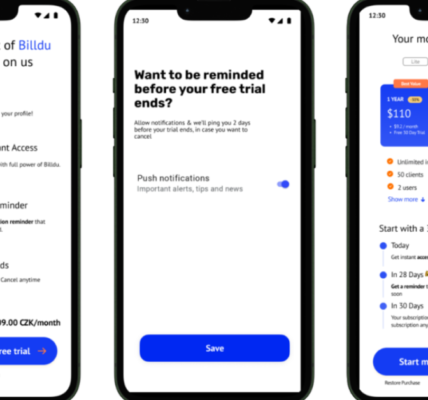If your digital product or service is built on subscriptions, you already know how crucial your paywall is. A well-optimized paywall can significantly increase conversion rates and, ultimately, maximize your subscription revenue. However, a static paywall often falls short of this potential, as it doesn’t cater to the varying needs and behaviors of different users. This is where A/B testing dynamic paywalls comes in, allowing you to experiment and tailor your approach to your audience. But how do you do this without a developer or deep coding knowledge? Enter RevenueCat, a no-code solution that makes A/B testing paywalls accessible for non-technical users.
In this comprehensive guide, we’ll walk you through how to leverage RevenueCat’s platform for effective paywall A/B testing. You’ll learn how to optimize your subscription model, segment your audience, and improve your paywall’s conversion rates—all without writing a single line of code.
Why A/B Testing Paywalls Is Essential for Subscription Success

One of the primary challenges with subscription-based businesses is the balance between providing enough value to convert users while also not overwhelming them with too many barriers to entry. If your paywall is too aggressive, you risk losing potential subscribers early in the user journey. On the flip side, if your paywall is too lenient, you might not generate enough revenue.
A/B testing your paywalls allows you to find that sweet spot where conversion rates are maximized, and revenue is optimized. A/B testing also gives you the ability to:
- Identify which paywall formats are most effective for different user segments (e.g., metered paywalls, hard paywalls, freemium models).
- Test different pricing strategies and figure out what pricing structures resonate with your users.
- Test timing and placement: Determining when your paywall should be triggered and how often it should appear is key to preventing user frustration.
- Boost user engagement: By showing personalized paywalls based on user behavior, you can enhance the user experience while improving conversion rates.
With proper A/B testing, you can take a data-driven approach to adjust your paywall to match user preferences, ultimately improving the efficiency of your subscription strategy.
Understanding RevenueCat: A No-Code Platform for Paywall Optimization
For those without coding knowledge, setting up and testing a dynamic paywall may sound daunting. But with RevenueCat, you can easily A/B test paywalls and optimize your subscription offerings—all without relying on a developer.
RevenueCat is a platform designed to simplify subscription management, providing tools for managing in-app purchases, subscriptions, and billing. With its A/B testing capabilities, RevenueCat allows you to test different paywall strategies, track user behavior, and analyze data—all from one platform.
RevenueCat simplifies the process by offering the following features:
- Easy Integration: Integrate RevenueCat with your existing systems without the need for a developer.
- User Segmentation: Segment users based on behavior or subscription status to serve different paywalls.
- Analytics Dashboard: Gain insights into how different paywall versions are performing with built-in analytics.
With RevenueCat, you can quickly set up multiple paywall variants, test them with specific user groups, and track which variations drive the best results.
Step 1: Define Your A/B Test Variables for Paywalls
Before diving into the testing phase, it’s essential to identify the specific elements of your paywall that you’ll be testing. Each test should focus on one or more variables to ensure you can draw meaningful conclusions. Here are some common paywall elements you can test:
Paywall Type:
- Metered Paywall: Allows users to access a set amount of content before the paywall is triggered.
- Freemium Paywall: Provides limited free content with the option to unlock premium features for a fee.
- Hard Paywall: Requires users to pay upfront to access any content.
Pricing Models:
- Flat-rate Pricing: Users pay a fixed amount for full access.
- Tiered Pricing: Different subscription plans with varying levels of access.
- Discount Offers: Test discounts such as a limited-time 30% off to see if it boosts conversions.
Paywall Timing:
- Time-based Triggers: Display the paywall after users have spent a certain amount of time on the site or app.
- Content-based Triggers: Display the paywall after users have consumed a certain amount of content (e.g., reading a specific number of articles).
- Milestone-based Triggers: Show the paywall after users reach specific milestones (e.g., interacting with a feature multiple times).
Once you have a clear idea of the variables you want to test, you can begin setting up the experiments in RevenueCat.
Step 2: Setting Up A/B Tests in RevenueCat
RevenueCat’s no-code interface makes it easy to set up A/B tests and assign different paywall versions to specific user groups. Here’s a breakdown of how to get started:
a. Create Different Paywall Variations:
Using RevenueCat’s platform, you can create multiple paywall variations. For example:
- Paywall Version A: A soft metered paywall with a 3-article limit.
- Paywall Version B: A freemium model with limited features but a premium content unlock option.
b. Segment Your Audience:
RevenueCat allows you to segment users based on behavior such as:
- User activity (e.g., new visitors vs. returning visitors)
- Engagement level (e.g., high-engagement users vs. casual readers)
- Subscription status (e.g., users who have subscribed vs. non-subscribed users)
By testing paywalls against different segments, you can tailor your offering to different types of users. For example, frequent readers may respond better to a discount offer, while casual users might prefer a metered paywall.
c. Configure A/B Testing:
RevenueCat allows you to easily set up experiments by assigning different user groups to the various paywall versions. You can configure the percentage of users who will see each variation and ensure that the test is statistically valid.
For example, you can assign 50% of your users to Paywall Version A and 50% to Paywall Version B. RevenueCat will automatically track the performance of each version and help you analyze the results.
Step 3: Monitor Performance with RevenueCat Analytics
Once your A/B tests are running, it’s time to monitor their performance. RevenueCat provides built-in analytics tools that allow you to track key metrics such as:
- Conversion Rates: Measure how many users convert into subscribers after encountering each paywall version.
- Churn Rates: Track how many users cancel their subscriptions after signing up.
- Revenue Per User (ARPU): Measure how much revenue you’re generating per user for each paywall variation.
- Engagement Metrics: Monitor how different paywall versions affect user behavior, such as time spent on the site and the number of articles read.
RevenueCat’s analytics dashboard provides real-time insights into how your paywalls are performing. By closely tracking these metrics, you can make data-driven decisions to improve your paywall strategy.
Step 4: Optimize Paywalls Based on Data
The key to successful A/B testing is iterating based on your data. After collecting sufficient test data, you can evaluate which paywall version is the most effective for converting free users into paying subscribers. This could mean adjusting your pricing, switching up the paywall type, or altering when and how your paywall is shown.
Here’s how to use the data to optimize your paywall:
- Paywall Type: If one version of the paywall has a higher conversion rate, that’s a good indication that users prefer that type. For instance, if the freemium model generates higher revenue than a hard paywall, you might consider offering a freemium model across all user segments.
- Pricing: If you’re testing different pricing strategies, look at the ARPU (Average Revenue Per User) and see which pricing model generates the highest revenue.
- Timing: If users respond better when the paywall is shown after reading three articles, you may want to adjust the timing for other user groups.
RevenueCat’s data-driven approach allows you to continuously refine your paywall strategy, ensuring that your subscription model remains optimized for maximum revenue.
Step 5: Scale Your Paywall Success
Once you’ve found the optimal paywall variation, it’s time to scale. RevenueCat allows you to automatically deploy your best-performing paywall across all user segments. Whether you’re showing a metered paywall or offering a freemium model, you can ensure that your most effective paywall strategy is consistently applied.
Conclusion
Testing and optimizing your paywall doesn’t have to be a complicated process, even if you lack coding skills. RevenueCat’s no-code platform empowers you to run A/B tests, segment users, and track performance—all without relying on a developer. By focusing on key variables such as paywall types, pricing strategies, and timing, you can test multiple variations and discover which approach maximizes conversion rates and subscription revenue.
With RevenueCat’s intuitive interface and powerful analytics tools, you can continuously iterate and refine your paywall strategy to ensure that you’re providing the best possible experience for your users—and maximizing your bottom line in the process.
By following the steps outlined in this guide, you’ll be well on your way to optimizing your paywall and scaling your subscription revenue without the need for any coding.




